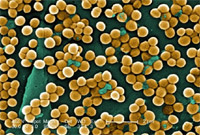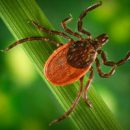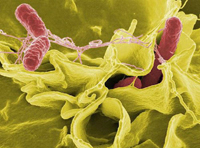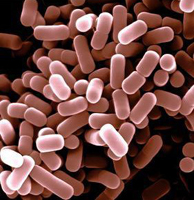What is Staphilococcus? What types of staphylococcus are? What to do if you have found staphylococcus? How the staphylococcus infection is treated? Answers to these questions you will find in the article.
Content
Cockki is an oval or spherical bacteria (the Greek word Kokkos is translated as
Grains»). Hundreds of a wide variety of coccobs surround a person throughout his life, but no,
Perhaps the microbe is better known than Staphylococcus.
Staphilococcus
The microbiological term staphylococcus was introduced into medical practice in the distant 1881. Under the microscope, it can be seen that the cockes are going to groups, similar to the bunch of grapes, hence the name, for staphylos in Greek, just means «bunch».
The word is - «Staphilococcus» - It is known now for almost everyone and few of whom it causes positive
emotions. Dozens of diseases of people and animals are obliged to their emergence of staphylococcus, in the treatment of these diseases, doctors are experiencing serious difficulties, no on the globe of a person who, at least once in life, did not have problems with Dorovo, related to staphylococcal.

Staphilococci is a whole genus of microorganisms, today there are already 27 species, with 14 species
Detected on the skin and mucous membranes of a person. Most staphylococci are absolutely harmless:
from the 14 species mentioned, only 3 are able to cause diseases, but also these three more than enough…
Danger and sickness of any bacterium, and staphylococcus in this aspect is no exception,
determined by the presence of the so-called «Pathogenic factors» - T. E. No microbe is dangerous in itself, but completely specific substances (or included in the microbe, or a microbe formed in the process of life). Figuratively speaking, not a soldier should be fearful, but a knife in his hand.
The uniqueness of staphylococcus is just that it is a soldier who was fucked by the most diverse
weapon from head to head. Microbial special forces, in short…
Little, unbelievable and stationary grains - namely, it looks like staphylococcus under a microscope, - it turns out to be a formidable opponent: each particle, each element of its structure, each biochemical process - a source of danger.
The surrounding staphylococcus microcapsule reflects the attacks of phagocytes (cells of the devourers of microbes),
promotes the penetration of bacteria in the body fabric. Cellular wall causes inflammatory and
Allergic reactions, neutralize immunoglobulins, immobilizes phagocytes. Numerous
Enzymes destroy cell structures, neutralize antibiotics. And still formed so-called
Hemolyzines - substances damaging red blood cells, leukocytes and many other cells. Hemolyzines whole four varieties, one of the other than the other. Already a considerable arsenal staphylococcus complement toxins - the strongest poisons, each with their own action, and all of them are not less than a dozen.
Detailed listing staphylococcus «harm» may seem the reader next and very
malicious medical scary. But it is impossible to do without these descriptions, for genuine
The essence of staphylococcal infections is precisely in a huge number of damaging factors -
amazing and not having analog in the microbial world.
On the one hand, it becomes clear a variety of staphylococcal diseases. This is not a different diphtheria chopstick with a single toxin and one-sole disease. From armed to the teeth staphylococcus, you can expect anything - and ulotnik on the skin, and meningitis, and inflammation of the lungs, and sepsis, and intestinal infection…
On the other hand, the true danger of concrete staphylococcus is determined by the presence
The aforementioned factors of pathogenicity. For it is not necessary that this microbe has all these horrors are present.
Types of Staphilococcus
Most staphylococci are peaceful guys, we have already talked about the fact that out of 14 species, on a person inhabiting, only 3 are able to cause diseases - precisely because only they have a weapon (those the most pathogenicity). That's about this Trinity and it is worth talking more.
So, there are three types of pathogens: Golden Staphylococcus (Latin -
Staphylococcus aureus, in analyzes and other medical documents, never write the name of the genus Staphylococcus, and limited to a big letter «S» - T.E. S. aureus), epidermal staphylococcus (s. Epidermidis) and saprophilic staphylococcus (s. SAPROPHYTICUS).
Saprofit Staphylococcus - the most «peaceful» And very rarely affects children. Large lover of women
Floor - most often and it is that women cause inflammation of the bladder (less often kidney), because
The main place of its habitat is the skin in the field of genitals and the mucous membrane of the urethra. Epidermal Staphylococcus - less picky, can live anywhere - on any mucous membranes, on any skin area - it was reflected in the name of the microbe (epidermis - surface layer of the skin). S.'s ability. Epidermidis cause disease is small - the body of a healthy person of any age (even a newborn) is easy to cope with it. Paradox: Lives epidermal staphylococcus on the skin, but no skin glands does not cause almost never. The absolute majority of infections arise in people weakened who have undergone operations in the intensive care unit. Microbe from the surface of the skin through wounds, drainage, vascular and urinary catheters penetrate the body… Blood infection may occur, and endocarditis (inflammation of the inner sheath of the heart). It is the epidermal staphylococcus - a genuine punishment for surgeons engaged in internal prosthetics: any artificial valves, vessels, joints if they are infected, then almost always this staphylococcal.
Finally, the most famous, sad, unfortunately, the famous Staphylococcus - Golden. On his background, all other representatives of the staphylococcal tribe seem to be peaceful domestic animals.
Almost all associated with staphylococcus medical problems imply the presence of
Golden Staphilococcus.
Only golden staphylococcus has a complete arsenal of damaging factors. Only he is able
Persistently and inmentarily fight back from antibiotics and antiseptics. No concerns, no discounts on the floor and age - both newborns, and adults, and old people: all vulnerable, are sensitive, susceptible… There is no such organ in the human body where it would not be able to penetrate the golden staphylococcus and wherever he could cause an inflammatory process. The emergence of at least 100 dangerous human diseases is directly related to the golden staphylococcus and only with it.
Staphylococcus infection
Under the microscope, golden staphylococcus colony have orange or yellow color - from here and
title. Microbe is amazingly resistant in external environment. Such stability has many other bacteria, but when influencing adverse factors, they form disputes - microbes die, disputes remain. After the external conditions improve, the disputes turn into bacteria, and they are already attacking the human body. Staphylococcus dispute does not forms. And, nevertheless, resistant. And always ready.
Golden Staphylococcus does not lose activity when drying. 12 hours live under the influence of direct sunlight. For 10 minutes, withstands the temperature in 150 s! Does not die in pure ethyl alcohol. Not afraid of hydrogen peroxide, moreover, produces a special catalase enzyme, which destroys hydrogen peroxide, and the microbe itself absorbs the oxygen.
Unique feature of staphylococcus - the ability to survive in sodium solutions chloride - T. E. Crash salt. 3 teaspoons of salt on a glass of water - withstand easy. Why it is so important? Yes because only staphylococcus can survive in sweat gland - salty human sweat to him! And the microbe produces an enzyme lipase, which destroys fats in general and greasy plug in the mouth of the hair bag in particular. Obvious and sad consequence: almost 100% of skin glasses (chirns, barley, furunculov, carbunculov and t. D.) - It is golden staphylococcus and only golden staphylococcus. Already the knowledge of this fact is easily convinced by the reader in the fact that there is no man on the globe, never had a staphylococcal illness: life live and never detect some acne for himself - almost impossible.
But there is a staphylococcus and its Achilles heel - completely strange, it is really incomprehensible, but very
High sensitivity to aniline dyes - first of all, to a solution of diamond green - the most ordinary greencraft, which is in every home.
Mentioned skin problems - an example of a typical golden staphylococcus agent.
Truly these flowers, in comparison with berries - common, or systemic infections. Microbe
produces a special enzyme - Coagulase (this enzyme in principle is only in golden
Staphylococcus). When staphylococcus falls from the surface of the skin in the vascular bed, then under the action
Coagulases begins coagulation of blood and bacteria inside the microtrombov - reliably
Hidden from protective factors of immunity. On the one hand, it may arise a staphylococcal
Sepsis (T. E. Blood infection caused by staphylococcus), on the other hand, staphylococcus can get into any organ and, accordingly, in any organ cause a purulent inflammatory process.
Most often there are staphylococcal pneumonia, damage to the heart valves, glans can
Detected anywhere - both in the liver, and in the brain, and in the kidneys. One of the most frequent problems - osteomyelitis (bone inflammation). Paradoxically, but at open fractures of bones osteomyelitis is not always staphylococcal, but when it arises «out of the blue» - culprit «Celebrations» Almost always turns out to be golden staphylococcus.
From the surface of the skin staphylococcus can penetrate into the chest (it is he who is the main cause of purulent mastitis), and from the mucous membranes of the upper respiratory tract - in the cavity of the ear, the apparent sinuses of the nose, fall down into the lungs (another version of the development of staphylococcal pneumonia).

And that is not all!! Staphylococci produces the strongest poisons (toxins), which by themselves
able to cause very severe diseases.
One of these toxins (exfoliatin) amazes newborns. Poison acts on the skin, causing
Education bubbles, like in burns. This disease even got a name «Syndrome Oshparny
Infants». Staphylococcal toxins are connected with toxic shock syndrome, described in 1980 at the dawn, women of sorbing tampons during menstruation period.
The most common toxic staphylococcus disease - food poisoning. Almost 50% of all
Golden Staphylococcis isolated enterotoxin - poison, causing the strongest diarrhea, vomiting, pain in
stomach. Staphilococci perfectly breed in many foods, especially love oil
Creams, vegetable and meat salads, canned food. In the process of breeding in food, toxin is accumulated, and
It is with toxin, and not with the microbe itself, the symptoms of the disease have a careless consumer.
A significant role is played by stability and microbes, and toxins to preserving salts concentrations, as well as the ability to withstand boiling.
That's what a malicious creature staphylococcus! The most interesting thing is that, despite
numerous enzymes and dangerous toxins, despite the striking stability in the external
Medium, microbe can not do anything with immune protection of a healthy person: against each poison
There is an antidote, a system of common and local immunity can neutralize factors
pathogenicity, restrain the reproduction of staphylococcus, prevent the occurrence of diseases!
On the surface of the skin, on the mucous membranes of the nasopharynk and vagina, in the intestine, finally, staphylococci can live for years, coexisting peacefully with a person and not harming him. Acquaintance with staphylococcus begins immediately after birth - almost all newborns are infected, but most of the microbe within a few days or weeks from the microbe. In the nasopherler, staphylococcus constantly lives in 20% of people, in 60% - episodically, and only every fifth has so strong protection that the carrier of the microbe is impossible.
Thus, staphylococcus completely and there is absolutely normal and natural
Representative again absolutely normal and natural microflora. But since
The potential harmfulness of such a neighborhood is obvious, it is not surprising that staphylococcus belongs to
Conditional pathogenic bacteria - T. E. microbes capable of causing diseases, but only under certain circumstances.
Any medical problems caused by staphylococcus providing for factors,
Human immune defense. Leather damage (injury, non-blood friction, violation
Hygiene rules) - Prerequisite for local purulent infections, decreased immunity due to other
disease, nutrition disorders, stress, hypovitaminosis - prerequisites for general infections, violation of the rules of cooking and storage of food - prerequisites for food poisoning.
But, and this is very (!) It is important to always distinguish such concepts as staphylococcus and staphylococcus
infection. Detection of staphylococcus in the absence of real symptoms of the disease is not at all reason
Immediate salvation and swallowing drugs.
With all the unambiguous theoretical justice of the above rule, practical actions… In practice, everything is often happening with accuracy, up to the contrary. In the milk of a healthy nursing woman, staphylococcus is found (as a rule, in general that came there from the surface of the skin) and this serves as a reason for the cessation of feeding! In the election of the feces on the dysbacteriosis or in a smear of ZEVA, the presence of staphylococcus was revealed, and in the absence of even hints on the infectious disease, at normal body temperature and the undisturbed general state of the child feed antibiotics! Moreover, staphylococcus often attribute diseases, in principle, not peculiar to him, accusing it in constipation, then in an allergic dermatitis, explaining his presence elevated gas formation in the intestine, jerking, and wrap, chin trembling, excessive formation of saliva, grunting nose and t. D. and T. NS.
Repeat, given the importance of the question: treat people, not analyzes (generally); Treat staphylococcus
infection, not staphylococcus (in particular).
Treatment of staphylococcal diseases
Treatment of staphylococcal diseases - a surprisingly difficult task, for there is no microbe capable of comparing with staphylococcus the ability to produce resistance to antibiotics and other antibacterial agents. The experience of the first application of Penicillina showed its effectiveness precisely in relation to staphylococcus. Passed a little more than half a century, and now you can only dream of such staphylococci. Pharmacologists synthesize all new and new antimicrobial agents, and microbiologists, with no less frequency, show staphylococcis, not sensitive to these means.
The main reason for this phenomenon is not only the staphylococcus itself, but also unreasonably widespread use
antibiotics in situations where without it you can do. Paradox, but even some
Staphylococcal diseases in treatment with antibiotics do not need - for example, food poisoning,
associated, as we have already spoken, not with the microbe itself, but with its toxins.
Staphylococcus Staphylococcus Return. The most dangerous and sustainable many drugs inhabit
Hospitals. Life is not easy there (and for bacteria including), but staphylococci survived in conditions
continuous use of disinfectants and mass use of antibiotics, -
The most serious risk factor, the basis of the so-called hospital infection.

Repeat: Treatment of staphylococcal diseases - the task is complicated, the path to its decision is long and roads, but quite real. Specific staphylococcus, resistant to all antibacterial agents - the phenomenon is very rare. Bacteriological methods allow not only to detect the culprit of the disease, but also to determine its sensitivity to drugs, after which the course of effective therapy. Purulent foci in the appropriate organs are eliminated by operational interventions, anti-staphylococcal plasma and immunoglobulins are also used, through which the finished antibodies are introduced into the body. The elimination of the provoking factors mentioned by us is of great importance - those that reduce immune defense and determine the principled possibility of the emergence of the disease.
Sadly, transferred staphylococcus infection does not leave after a long-term immunity. The number of possible pathogenicity factors is too large. Antibodies appeared to toxins of one staphylococcus blood, but the result of the meeting with another microbe is not predictable, for it can have other toxins, the body is not yet familiar.
Humanity is doomed to live next door to staphylococcus. Neighborhood is not the most pleasant, but
tolerant. All that we can in this situation is to avoid conflicts. Maintain in order to strengthen and put the fence in time (t. E. immunity system) and strictly observe the nonsense pact - do not throw stones in the neighbor (antibiotics) until it touches us.









